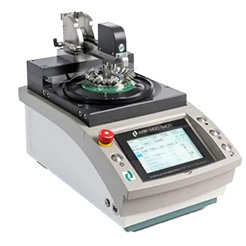Frequently, my customers ask for guidance to develop a fiber optic polishing process.
While there are many details to consider, the process comes down to 5 basic steps.
Note that this article focuses on single-fiber (and not MT) PC ferrules. While much of my advice applies to APC polishing, those connectors require additional considerations.
Step 1. Define your objectives, especially measurement criteria and process yields.
When developing a polishing process, it’s important to clarify your acceptance criteria and targeted yields – and have the ability to accurately measure and quantify pass/fail results. For example, do your polished ferrules need to meet an end-face geometry specification such as those specified in Telcordia GR-326? Also, virtually all polished fiber optic ferrule end-faces must meet SOME visual appearance specifications. What criteria will you use to determine if your polishing results are acceptable or not?
When developing a polishing process, I highly recommend that your initial targets are to meet GR-326 geometry requirements and IEC 61300-3-35 visual requirements – with a minimum yield expectation of 95% passing.
Step 2. Ensure you have the proper equipment.
Of course, it would be ideal if you are starting with all-new polishing equipment. The precision of polishing equipment dimensions (both the fixturing as well as the machine itself) plays a vital role in determining your process capabilities. Properly maintained polishing machines should last for decades, so be sure to follow the manufacturer’s maintenance recommendations.

Polishing fixtures wear out more quickly depending, of course, on the amount of use. If you follow the recommendations below and still find it impossible to get acceptable results (particularly in Apex Offset), it’s very possible you may need to procure new fixtures.
Regardless of whether your customer or product design requires you to meet geometry specifications, it is HIGHLY recommended that you measure geometries during process development, using an interferometer. This is an expensive piece of equipment (typically $20,000 or more), but it is invaluable to developing a robust polishing process. If the cost is prohibitive, look into renting or borrowing an interferometer.
Be sure your equipment is capable of properly measuring what you need it to measure, particularly regarding the visual inspection. For example, if you need to meet single-mode requirements of IEC 61300-3-35, does your microscope have a high-resolution system as defined within the spec? If you are inspecting APC ferrules, do you have an APC adapter for your scope or just the PC adapter? (Unfortunately, it’s fairly common to find production lines inspecting APC ferrules with a PC adapter, which is improper. With the APC ferrule end-face at an angle to the microscope optics, the entire fiber end-face will never be in proper focus, making it very difficult to detect small defects.)
When developing a polishing process, be sure to use only brand-new rubber polishing pads (Machine and Manual). Rubber pads play a critical role in polish results and are often overlooked. Having a consistent hardness (durometer) across the surface of the rubber pad is CRITICAL in getting consistent polishing results. Rubber hardness will change over time, so rubber pads always need to be replaced periodically (once a year, at minimum).
Step 3. Conduct a trial run, following our recommended procedures.
Fiber Optic Center offers Recommended Polishing Procedures for Domaille and Seikoh Giken polishing machines – by far the two most popular polishing platforms used today. However, due to variations in ferrule material, connector design, and even in machine/fixturing dimensions, it is likely that you will need to modify some of the recommended machine settings. Use Fiber Optic Center’s recommended polishing settings as a starting point, and budget time to modify as needed based on your results.
Step 4. To adjust your process, start with a focus on Radius.
The ability to achieve desirable, consistent Radius values is critical to developing a fiber optic polishing process. Radius is the first geometry parameter to bring under control. Why? Because the Radius value is an excellent indicator of consistency in polishing pressure and the amount of ferrule material removed during the process – important factors that highly impact all results, including visual appearance and angle (particularly with conical-style APC ferrules). When all polished ferrules have an identical Radius after polishing, this indicates that all ferrules have undergone consistent polishing conditions.
After polishing a group of connectors, use the interferometer to measure geometry and focus on the Radius values. As a rough rule of thumb, a stable Radius variation on one plate of ferrules should be less than 2mm. If the variation is higher, you likely have a process issue or your polishing equipment is subjecting ferrules to varying pressure.
Generally speaking, the smaller your average Radius value, the smaller the deviation in results will be. It is usually a good idea to aim for the lower end of the Radius specification rather than the middle or upper end of the spec. For example, if the Radius spec limits are 7-25mm, you’ll usually have better and more consistent results if you target 10-12mm as opposed to 18-20mm.
How to decrease or increase Radius values:
- Decrease Radius values by applying more pressure or using a softer rubber pad.
- Increase Radius values by applying less pressure or using a harder rubber pad.
When your Radius values are under control, look at another key geometry parameter: Apex (also called Apex Offset). This reflects the angle of the polished end-face. If the Apex values are too large, this means your ferrules are being polished at an angle that is too large. All other conditions being equal, a smaller Radius value will generally result in a better Apex value. This is another reason to aim for an average Radius value toward the lower end of spec limits. If you’re already dialed-in on desired Radius values and the Apex values remain unacceptable, the cause is likely related to worn polishing fixtures or worn rubber pads. In both cases, the only fix is to replace the worn fixture or rubber pad.
Step 5. Conduct a visual inspection.
Your customers will require some type of visual inspection. (Clearly, you cannot ship a connector with a shattered fiber.) After achieving desired geometry values, measure the visual appearance of the end-face, looking for 2 types of defects: pits and scratches. Typically, pitting can be resolved by increasing time during the intermediate (diamond) polishing steps. The consistent appearance of a large quantity of fine scratches (the “skating rink” appearance) is likely due to insufficient time and/or pressure on the final polishing step. The sporadic appearance of a few scratches is likely caused by contamination, due to insufficient cleaning.
When developing a polishing process, carefully evaluate other major visual defects: shattered fibers, core cracks, no visible fiber, etc. In many cases, the cause of the defect is not related to your polishing process but rather to cleaving, product handling, curing temperatures, and so forth. These defects are real and need to be corrected, but you should address the root cause of these issues by preventing them from happening and not relying on your polishing process to remove large fiber defects, which only adds to the time, cost, and instability of your polishing process.
Final thoughts:
- Cleaning is critical – The act of polishing removes material, similar to sanding wood. To prevent contamination, it’s vital to thoroughly clean the fixture and ferrules between every polishing step. Contamination causes scratching and will negatively impact visual yields.
- Focus on preventive action, not corrective action – As you develop your fiber optic polishing process, I encourage you to implement a statistical process control system. For example, over time, rubber pads and fixtures will wear out, and yields will begin to degrade. Record the data, track it, and actively analyze it. This will help you to prevent problems rather than fixing issues after they occur. Watch the trends and take preventive action, and you’ll consistently see high yields.
Additional resources from the FOC team include:
- View Polishing Technical Solution Content
- View the Glossary, Acronyms, Military Specifications for Connectors
- Q&A Resource: email technical questions to AskFOC@focenter.com
Do you have a specific issue regarding your polishing process?
Send us your question, and we’ll do our best to provide guidance. Fiber Optic Center is committed to helping you manufacture the best fiber optic cable assemblies possible. Fiber Optic Center is a resource for questions on this and all technical subjects. AskFOC can be found at: https://focenter.com/askfoc/ and the Fiber Optic Center technical experts will answer your questions here.



